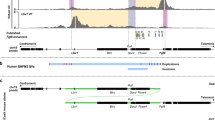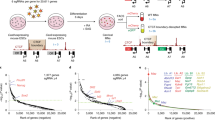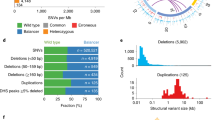Abstract
The genome is organized in three-dimensional units called topologically associating domains (TADs), through a process dependent on the cooperative action of cohesin and the DNA-binding factor CTCF. Genomic rearrangements of TADs have been shown to cause gene misexpression and disease, but genome-wide depletion of CTCF has no drastic effects on transcription. Here, we investigate TAD function in vivo in mouse limb buds at the Sox9–Kcnj2 locus. We show that the removal of all major CTCF sites at the boundary and within the TAD resulted in a fusion of neighboring TADs, without major effects on gene expression. Gene misexpression and disease phenotypes, however, were achieved by redirecting regulatory activity through inversions and/or the repositioning of boundaries. Thus, TAD structures provide robustness and precision but are not essential for developmental gene regulation. Aberrant disease-related gene activation is not induced by a mere loss of insulation but requires CTCF-dependent redirection of enhancer–promoter contacts.
This is a preview of subscription content, access via your institution
Access options
Access Nature and 54 other Nature Portfolio journals
Get Nature+, our best-value online-access subscription
$29.99 / 30 days
cancel any time
Subscribe to this journal
Receive 12 print issues and online access
$209.00 per year
only $17.42 per issue
Buy this article
- Purchase on Springer Link
- Instant access to full article PDF
Prices may be subject to local taxes which are calculated during checkout





Similar content being viewed by others
Code availability
Our pipeline for cHi-C data processing outlined above, as well as custom codes used in this study, will be provided upon request.
References
Bonev, B. & Cavalli, G . Organization and function of the 3D genome. Nat. Rev. Genet. 17, 661–678 (2016).
Lieberman-Aiden, E. et al. Comprehensive mapping of long-range interactions reveals folding principles of the human genome. Science 326, 289–293 (2009).
Rao, S. S. et al. A 3D map of the human genome at kilobase resolution reveals principles of chromatin looping. Cell 159, 1665–1680 (2014).
Nora, E. P. et al. Spatial partitioning of the regulatory landscape of the X-inactivation centre. Nature 485, 381–385 (2012).
Dixon, J. R. et al. Topological domains in mammalian genomes identified by analysis of chromatin interactions. Nature 485, 376–380 (2012).
Furlong, E. E. M. & Levine, M. Developmental enhancers and chromosome topology. Science 361, 1341–1345 (2018).
Spielmann, M., Lupiáñez, D. G. & Mundlos, S. Structural variation in the 3D genome. Nat. Rev. Genet. 19, 453–467 (2018).
Nora, E. P. et al. Targeted degradation of CTCF decouples local insulation of chromosome domains from genomic compartmentalization. Cell 169, 930–944.e22 (2017).
Fudenberg, G. et al. Formation of chromosomal domains by loop extrusion. Cell Rep. 15, 2038–2049 (2016).
Sanborn, A.L. et al. Chromatin extrusion explains key features of loop and domain formation in wild-type and engineered genomes. Proc. Natl Acad Sci. USA 112, E6465–E6465 (2015).
Vietri Rudan, M. et al. Comparative Hi-C reveals that CTCF underlies evolution of chromosomal domain architecture. Cell Rep. 10, 1297–1309 (2015).
Schwarzer, W. et al. Two independent modes of chromatin organization revealed by cohesin removal. Nature 551, 51–56 (2017).
Wutz, G. et al. Topologically associating domains and chromatin loops depend on cohesin and are regulated by CTCF, WAPL, and PDS5 proteins. EMBO J. 36, 3573–3599 (2017).
Busslinger, G. A. et al. Cohesin is positioned in mammalian genomes by transcription, CTCF and Wapl. Nature 544, 503–507 (2017).
Rao, S. S. P. et al. Cohesin loss eliminates all loop domains. Cell 171, 305–320.e24 (2017).
Franke, M. et al. Formation of new chromatin domains determines pathogenicity of genomic duplications. Nature 538, 265–269 (2016).
Lupianez, D. G. et al. Disruptions of topological chromatin domains cause pathogenic rewiring of gene-enhancer interactions. Cell 161, 1012–1025 (2015).
Weischenfeldt, J. et al. Pan-cancer analysis of somatic copy-number alterations implicates IRS4 and IGF2 in enhancer hijacking. Nat. Genet. 49, 65–74 (2016).
Bi, W., Deng, J. M., Zhang, Z., Behringer, R. R. & de Crombrugghe, B. Sox9 is required for cartilage formation. Nat. Genet. 22, 85–89 (1999).
Barrionuevo, F. et al. Homozygous inactivation of Sox9 causes complete XY sex reversal in mice. Biol. Reprod. 74, 195–201 (2006).
Rodriguez-Carballo, E. et al. The HoxD cluster is a dynamic and resilient TAD boundary controlling the segregation of antagonistic regulatory landscapes. Genes Dev. 31, 2264–2281 (2017).
Narendra, V., Bulajić, M., Dekker, J., Mazzoni, E. O. & Reinberg, D. CTCF-mediated topological boundaries during development foster appropriate gene regulation. Genes Dev. 30, 2657–2662 (2016).
Boija, A. et al. Transcription factors activate genes through the phase-separation capacity of their activation domains. Cell 175, 1842–1855.e16 (2018).
Wendt, K. S. et al. Cohesin mediates transcriptional insulation by CCCTC-binding factor. Nature 451, 796–801 (2008).
Zabidi, M. A. et al. Enhancer–core-promoter specificity separates developmental and housekeeping gene regulation. Nature 518, 556–559 (2014).
Kraft, K. et al. Serial genomic inversions induce tissue-specific architectural stripes, gene misexpression and congenital malformations. Nat. Cell Biol. 21, 305–310 (2019).
Artus, J. & Hadjantonakis, A.-K. Generation of chimeras by aggregation of embryonic stem cells with diploid or tetraploid mouse embryos. Methods Mol. Biol. 693, 37–56 (2011).
Ruf, S. et al. Large-scale analysis of the regulatory architecture of the mouse genome with a transposon-associated sensor. Nat. Genet. 43, 379–386 (2011).
Andrey, G. et al. Characterization of hundreds of regulatory landscapes in developing limbs reveals two regimes of chromatin folding. Genome Res. 27, 223–233 (2017).
Buenrostro, J. D., Giresi, P. G., Zaba, L. C., Chang, H. Y. & Greenleaf, W. J. Transposition of native chromatin for fast and sensitive epigenomic profiling of open chromatin, DNA-binding proteins and nucleosome position. Nat. Methods 10, 1213–1218 (2013).
Langmead, B. & Salzberg, S. L. Fast gapped-read alignment with Bowtie 2. Nat. Methods 9, 357–359 (2012).
Ramirez, F. et al. deepTools2: a next generation web server for deep-sequencing data analysis. Nucl. Acids Res. 44, W160–W165 (2016).
Wingett, S. et al. HiCUP: pipeline for mapping and processing Hi-C data. F1000Res. 4, 1310 (2015).
Durand, N. C. et al. Juicer provides a one-click system for analyzing loop-resolution Hi-C experiments. Cell Syst. 3, 95–98 (2016).
Knight, P. A. & Ruiz, D. A fast algorithm for matrix balancing. IMA J. Numer. Anal. 33, 1029–1047 (2013).
Acknowledgements
This study was supported by grants from the Deutsche Forschungsgemeinschaft (KR3985/7-3 and MU 880/16-1 to S.M.). We thank J. Fiedler and K. Macura (transgenic unit) and M. Hochradel (sequencing core facility) of the MPIMG, A. Stiege and U. Fischer for help with cloning and cell culture, and N. Brieske for in situ hybridizations. We also thank M. Robson, F. Martinez-Real and all members of the Mundlos laboratory for input and discussions.
Author information
Authors and Affiliations
Contributions
D.M.I. and S.M. conceived the project. A.D., D.M.I. and M.F. performed cHi-C. R.S. and D.M.I. performed the computational analysis with input from M.V. D.M.I., A.D., S.A. and M.F. produced transgenics, carried out transgenic validation and performed expression–phenotypic analysis. C.P. performed ATAC-seq. A.D., I.J. and D.M.I. performed ChIP-seq. B.T. oversaw sequencing of the cHi-C, ChIP-seq and ATAC-seq. L.W. performed morula aggregation. W.-L.C. performed micro-CT analysis. D.M.I., A.D. and S.M. wrote the manuscript with input from the authors.
Corresponding authors
Ethics declarations
Competing interests
The authors declare no competing interests.
Additional information
Publisher’s note: Springer Nature remains neutral with regard to jurisdictional claims in published maps and institutional affiliations.
Integrated supplementary information
Supplementary Figure 1 Gradual fusion upon progressive CTCF site deletion.
(A) cHiC chromatin interactions from wildtype and mutant E12.5 mouse embryonic limb buds (n=1). CTCF ChIP-seq with binding site orientation (red/blue) at the boundary and intra-TAD are highlighted. Two-headed arrow indicates two significant motifs (FIMO, p<10-4) underlying the ChIP-seq peak. Virtual 4C from Kcnj2 (blue) and Sox9 (orange) below each map. Progressive deletion of CTCF sites causes progressively increasing interaction between Sox9- and Kcnj-TADs (B) Subtraction maps for the same region show increases (red) and decreases (blue) in interactions upon deletion of additional intra-TAD CTCF-sites.
Supplementary Figure 2 Minor gene expression changes and absence of digit phenotypes upon CTCF-site deletion.
(A) Gapdh normalized expression of Kcnj2 and Sox9 in E13.5 limb buds from heterozygous and homozygous littermates measured via qRT-PCR (wildtype = 1). Bars represent the mean, error bars the standard deviation. Significance relative to wildtype levels tested via one-sided, unpaired t-test (n=1-4, see diamonds; n.s.: not significant, p<0.05:*, p<0.01:**, p<0.001:***, n.a.: not available) (B) Normal Kcnj2 and Sox9 expression pattern in ΔBorC1-2 E12.5 embryos by WISH. Zoom-In shows hindlimb in detail (n≥2) (C) 3D micro-computed tomography scan of terminal phalanges from wildtype and mutant adults (n≥2; 7-12w).
Supplementary Figure 3 Schematic of the inversion series at the Kcnj-Sox9 locus.
Position of the Kcnj2 and Sox9 genes, TAD boundary (red hexagons), and CTCF sites (blue ticks) in wildtype and mutant genomes are indicated. Grey boxes indicate the extent of the inverted region.
Supplementary Figure 4 Subtle differences in interactions upon intra-TAD inversion (Inv-Intra).
Virtual 4C-profiles derived from cHi-C maps (wildtype and Inv-Intra) mapped to a wildtype genome (n=1). 4C-profiles from viewpoints at Sox9, the TAD boundary, and Kcnj2 are shown for wildtype (orange) and Inv-Intra (orange). Subtraction of the two profiles shows systematically more contacts at the Boundary and Sox9 viewpoints depending on orientation of TAD substructure for the. The control viewpoint (Kcnj2) shows no systematic changes. Note changes in interaction frequency of Sox9 or the TAD boundary upon inversion of the TAD substructure. Dashed boxes indicate changes in interaction at the C1-C4 CTCF sites.
Supplementary Figure 5 Distinct changes in enhancer interaction upon CTCF-site deletion and structural variations.
(A) Normalized enhancer interaction of the Sox9 and Kcnj2 promoters with genomic bins containing putative enhancers and enhancers tested in transgenic reporter mice (bold). Candidate enhancers E33 and E34 were omitted due to proximity to the Sox9 promoter. Contact counts were extracted from scaled cHiC maps with 10kb bin size. (B) Comparison across alleles of three enhancers. *CTCF indicates that E1 interaction is mediated mainly by the proximal C1 CTCF site. Relative position of the Sox9 promoter is also indicated.
Supplementary Figure 6 Re-direction of genomic interactions leads to Sox9 loss and Kcnj2 gain in expression and developmental phenotypes.
(A) Gapdh normalized expression of Kcnj2 and Sox9 in E13.5 limb buds from heterozygous and homozygous littermates measured via qRT-PCR (wildtype = 1). Error bars represent the std, deviation the mean, diamonds the individual data points. Significance relative to wildtype (n=2-4 see diamonds, one-sided, unpaired t-test; n.s.: not significant, p<0.05:*, p<0.01:**, p<0.001:***). Note the allele-specific regulatory changes in InvC and InvCΔBor littermates. Homozygous Bor-KnockIn embryos were generated by tetraploid aggregation. (B) Loss of dorsal flexion, sesamoid bones, and claw-shaped form of the terminal phalanx in adult (7-12w) InvC and InvCΔBor animals shown by 3D micro-computed tomography. (C) Fully penetrant phenotype of homozygous InvC E18.5 littermates (n=2 (het) 4 (hom)). Top, lateral view of the head, note short snout and micrognathy in the homozygous embryo. Bottom, Skeletal preparation of littermates show Sox9-LOF characteristic skeletal defects (sternum/rib defects, delayed ossification, dysplastic digits and scapula, cleft palate). (D) Homozygous Bor-KnockIn phenotype in P0-animals derived from tetraploid aggregation (n=3). Top, schematic of the targeting construct containing the four CTCF sites of the TAD boundary (6.3 kb). Homology arms are 2 and 4 kb. Top right: lateral view of P0 newborn, note short snout and micrognathy. Bottom: Bor-KnockIn phenotype displays Sox9-LOF like defects. Note the overall milder defects compared to InvC and absence of a digit phenotype.
Supplementary information
Supplementary Information
Supplementary Figs. 1–6
Supplementary Table 1
List of primers used in this study.
Supplementary Table 2
Enhancer–promoter interactions. Normalized enhancer interaction of the Sox9 and Kcnj2 promoters with genomic bins containing putative enhancers (see also Supplementary Fig. 5).
Rights and permissions
About this article
Cite this article
Despang, A., Schöpflin, R., Franke, M. et al. Functional dissection of the Sox9–Kcnj2 locus identifies nonessential and instructive roles of TAD architecture. Nat Genet 51, 1263–1271 (2019). https://doi.org/10.1038/s41588-019-0466-z
Received:
Accepted:
Published:
Issue Date:
DOI: https://doi.org/10.1038/s41588-019-0466-z
This article is cited by
-
Structural variants in the Epb41l4a locus: TAD disruption and Nrep gene misregulation as hypothetical drivers of neurodevelopmental outcomes
Scientific Reports (2024)
-
Epiphany: predicting Hi-C contact maps from 1D epigenomic signals
Genome Biology (2023)
-
β-actin mediated H3K27ac changes demonstrate the link between compartment switching and enhancer-dependent transcriptional regulation
Genome Biology (2023)
-
Premature ovarian insufficiency is associated with global alterations in the regulatory landscape and gene expression in balanced X-autosome translocations
Epigenetics & Chromatin (2023)
-
The spatial organization of transcriptional control
Nature Reviews Genetics (2023)



